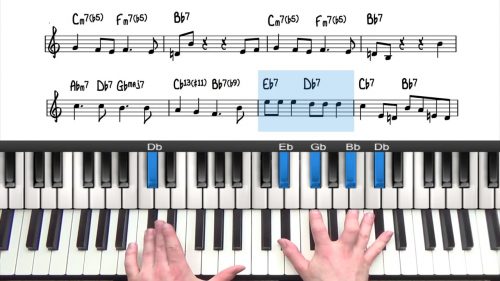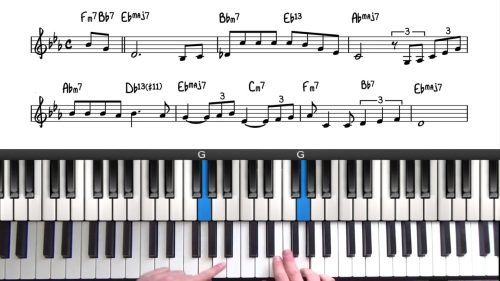Body & Soul Vocal Arrangement
Welcome to this advanced lesson on Body and Soul for the accompanying pianist.
In lesson 1, we built a strong foundation in this tune. With this foundation we know the melody and harmony so well, that we can follow our singer in spontaneous chording, going from simple triads to 7th chords, rooted to inversions, all in response to the moment.
Full Arrangement & Intro
This video is going to address this tune in a different direction. We are going to take advantage of our practice time to build a set arrangement of voicings that maps out an intro, sets up our singers and supports our singer melodically as well as placing extensions and fills perfect spots to compliment but not take away from the singer’s line.
Creating An Introduction
We start this lesson by creating an introduction. You have a couple of options here. The first option is to play through the first A Section. The tune follows an AABA form, and so playing the first A section will lead you smoothly and convincingly into the first chord of the tune, and create a nice harmonic setting for the singer to enter.
The second option is a shorter intro, using just the turnaround from the end of the first A Section. This 2 bar intro can be used to set the tone of the performance and get your singer off to a great start.
Identify Places To Add Fills
We will identify the places in the form that are well-suited to add fills. Generally, this is where the melody and/or harmony is static. You should identify these areas before the performance and practice fills and runs so that you are comfortable filling in the space. The examples in this lesson will help you understand how this is done.
Ending The Tune
Your singer will be dictating a lot of things, in particular, the intro and the outro. There are many different ways to end the tune when accompanying a vocalist. For Body & Soul, the most common approach that you will hear is the direct rubato ending. This is where the singer will slow down the lyrics and you must follow and support the singer in your accompaniment.
Practice Tips
-
Spend some time with the previous lessons to get very familiar with the underbelly of the tune – internalizing the melody and harmony, memorizing and feeling super comfortable with it.
-
Notice these extensions in the last chord of the intro... Bbalt7. This might make it difficult for the singer to hear their starting note, so including the melody in the first chord of my arrangement will ensure a good start.
-
It sounds good to echo the melody in places. If the singer is rolling and doing their own thing, then you can always leave it out. But you should practice it so you can play it if needed.
-
You can use the exact same chords for all of the A Sections if you like. But for the sake of this video and for my own tastes, I like to change things up. You have the creative freedom to build your own arrangement.





